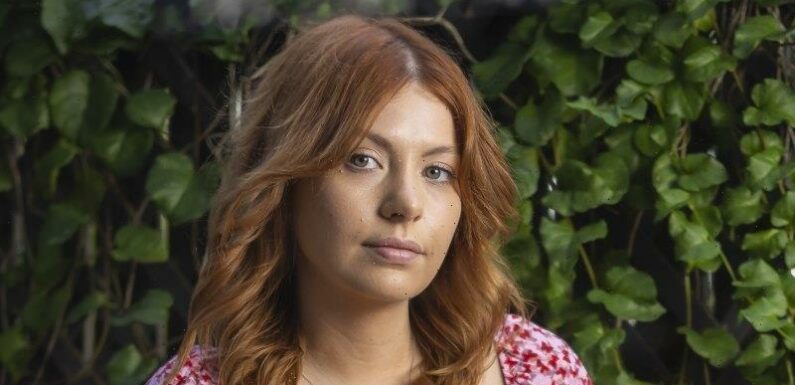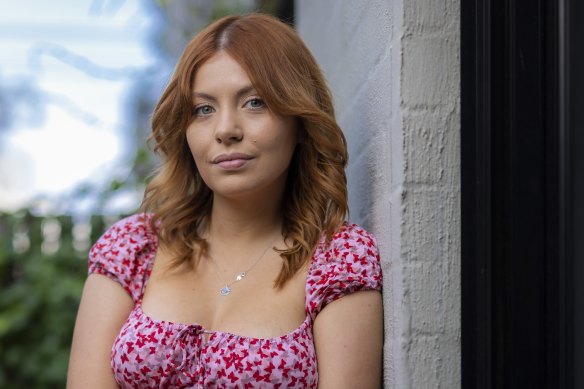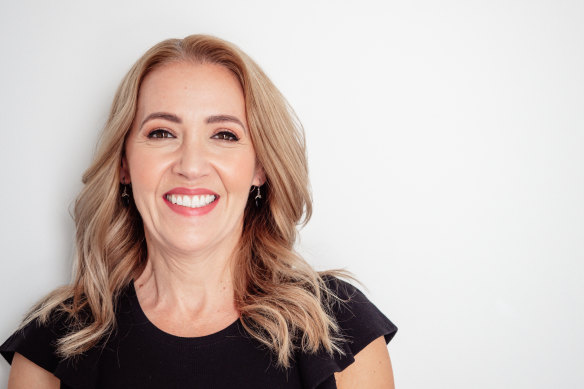
Emma Fitzgerald knows women can be hard on themselves and do not want to risk wasting their doctor’s time, so often they don’t visit a GP when they should.
“We don’t want to come across as nagging or whining,” says the young TV producer. “We dismiss things as little that are not so little.”
Emma Fitzgerald says women can be hesitant to seek medical help for symptoms that can be “easily dismissed”, but they need to feel confident to to do so.Credit:Wayne Taylor
But after an ovarian cancer diagnosis at age 26 she wants to make sure others don’t put off a trip to the GP with their symptoms.
Fitzgerald thought she was gaining weight during the 2020 lockdowns, and overlooked the fact she felt constantly tired and had abdominal pain.
She dismissed the visible protrusion in her abdomen as inevitable COVID-kilos, put her fatigue down to garden-variety lockdown stress, and attributed her pain to cramps.
She did not suspect she had developed a variety of cancer usually associated with women more than twice her age, a disease dubbed a silent killer because it is the deadliest women’s cancer, often not detected until an advanced stage.
“If I had been weighing myself I would have realised I was losing weight during lockdown … (but) I was looking in the mirror and saying, ‘Oh look, my stomach is enormous’.
“We all think the worst of ourselves if you don’t have someone to draw you out and say, ‘no, this is not normal’,” she says.
When Fitzgerald returned to the office as an associate producer at Channel Ten’s The Project, a supportive manager noticed she appeared to be in pain and suggested it may be coming from her ovaries.
Fitzgerald took her advice and went to the GP, who could feel a large mass on her ovary.
Angelina Jolie’s decision to have her ovaries removed after discovering she had the BRCA1 gene mutation, which made it more likely she would develop breast and ovarian cancer, has promoted more Australian women to have preventative surgery.Credit:Shutterstock.com
Thankfully, the type of tumour she had could be surgically removed. But now, like Royal Women’s Hospital oncology director Professor Orla McNally, Fitzgerald wants women to act on any health concerns by seeing their doctor.
“For a woman with ovarian cancer at a young age, often it is picked up incidentally,” McNally says, “because they have presented with what might be benign gynaecological symptoms.
“If it is found, it is then very important that a woman be referred to an appropriate team of specialists. This sets in chain looking for any genetic reason it might have arisen.”
Ovarian cancer is much more common among post-menopausal women, with 64 the most common age to be diagnosed.
Emma Fitzgerald wants women to know they are not being dramatic if they feel something needs investigating by their doctor.Credit:Wayne Taylor
The subtypes found in younger patients are also more likely to be treatable, McNally explained.
“As a result, younger women often have a better prognosis,” she said.
With no early detection screening, ovarian cancer, has a 49 per cent five-year survival rate, much lower than the 90 per cent for breast and prostate cancer patients, Ovarian Cancer Australia chief executive Jane Hill says.
Hill wants women to be aware common symptoms include increased abdominal size or persistent bloating, abdominal or pelvic pain, feeling full after a small meal, or needing to urinate often or urgently.
“If you’re experiencing those symptoms, and they’re unusual or persistent, you should go to see your doctor,” she says. “The problem is women are so busy; we’re mothers and have work and other commitments and often put our health second.”
Each year 1800 pre-menopausal Australian women are diagnosed with ovarian cancer, compared to about 20,000 older women.
Of these, 15 per cent carry the BRCA1 gene mutation that caused actor Angelina Jolie to decide to have her breasts and ovaries removed in preventative surgery. Jolie’s mother, Marcheline Bertrand, died from ovarian cancer aged 56.
The BRCA1 mutation predisposes women to a much higher risk of both cancers. The so-called “Angelina Jolie effect” has since led to an increase in Australian women choosing similar surgery.
Sarah Powell had breast cancer at 29, and subsequently discovered she carried the BRCA1 gene mutation, which pre-disposes her to ovarian cancer. She had her ovaries removed at 38.
Data from the Royal Women’s Hospital shows 481 women have had gynaecological risk-reduction (preventative) surgery since 2010, with a notable spike in the procedure since Jolie wrote about having her ovaries removed in 2014.
The mutation can be handed down to female children from male forebears and is more common in descendants of European, or Ashkenazi, Jewish people.
Sarah Powell discovered she carried BRCA1 mutation after she sought genetic testing following her breast cancer diagnosis at 29. Now the chief executive at the hereditary cancer organisation Pink Hope, Powell had her ovaries removed at age 38.
“I just feel incredibly fortunate I could remove that risk of ovarian cancer when so many don’t have that option,” Powell said.
She urges women to investigate their family heritage, and not to feel like “drama queens” if they decide to see a GP.
Emma Fitzgerald, now 29 and well, agrees, saying she wants peers to feel confident they can “make some noise” if something doesn’t seem right.
“My biggest thing is, don’t dismiss it,” she says. “You’re not annoying your doctor by taking your health seriously.”
February is Ovarian Cancer Awareness month, funding to provide resources, including specialist ovarian cancer nurses, to the five Australian women diagnosed each day with the disease is being collected by Ovarian Cancer Australia on February 23. Donations on the day will be matched by private donors.
Make the most of your health, relationships, fitness and nutrition with our Live Well newsletter. Get it in your inbox every Monday.
Most Viewed in National
From our partners
Source: Read Full Article



